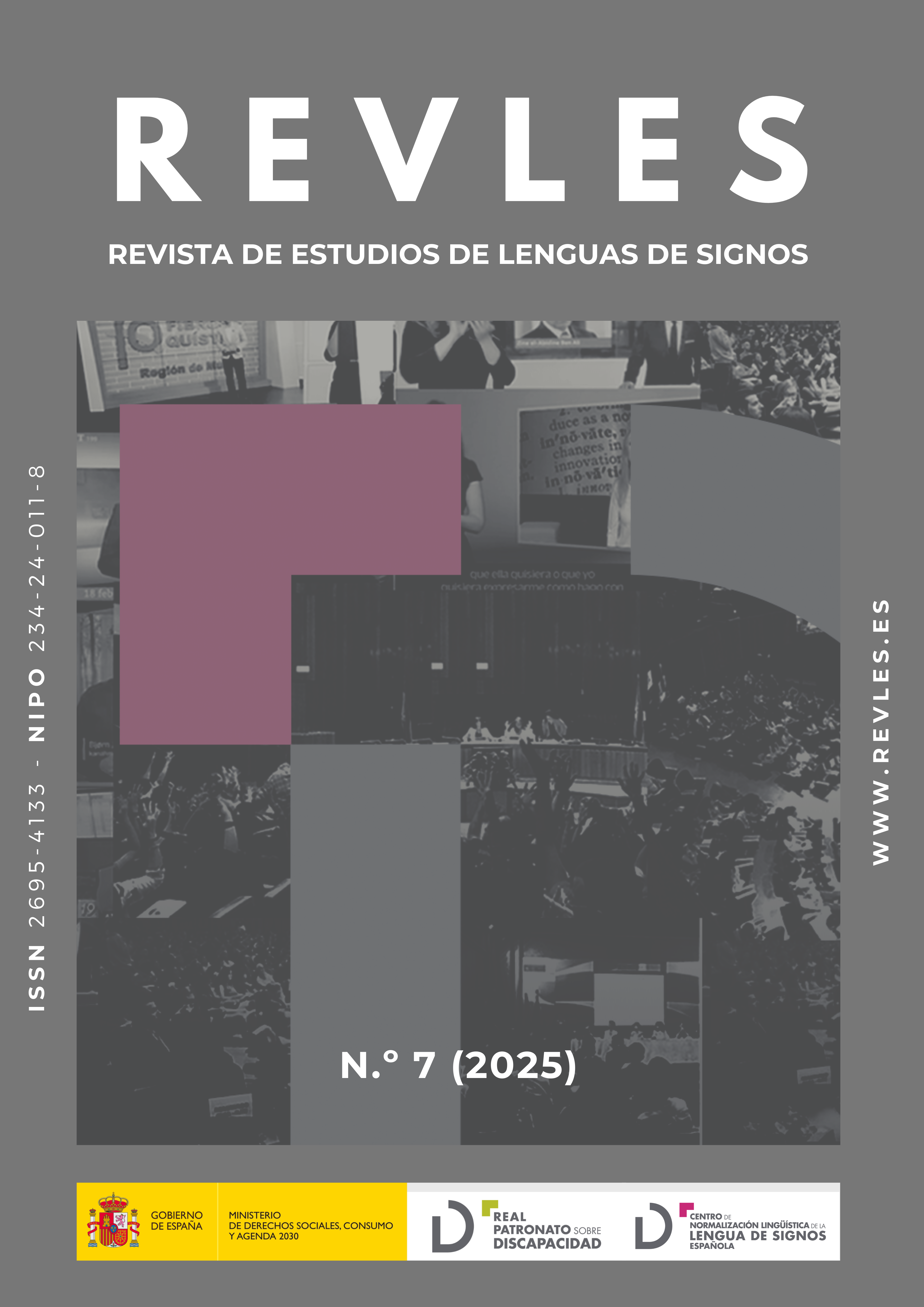Abstract
One of the biggest problems, reflected by sign language interpreting professionals, refers to the lack of prior preparation. In addition, we must bear in mind one of the aspects inherent to the visuo-gestural language with which we work, the sign language, which needs a great cognitive and physical competence. Our main object of study is whether the knowledge, the previous analysis of the discursive context and its preparation to interpret affect the physical effort and subsequent fatigue of the professional. Mixed methodology research has been carried out from an interdisciplinary perspective. On the one hand, the qualitative methodology of Critical Discourse Analysis for the collection of information from the discursive context to sign language interpreting professionals in different areas and, on the other, the quantitative methodology taking the physiological measurements of the musculature involved in the population studied through tensiomiography. The information that is available in advance about the text, the place of interpretation and the users, plus the knowledge of everything that happens, provides better tools to carry out the work of the sign language interpreting professionals. The results of this study also show that professionals have a higher level of muscle stiffness in all the muscles evaluated, in addition to evidencing fatigue due to overstress (excess use of the muscle) in the face of repeated movement over time. Regarding physical preparation, the knowledge and awareness about its relevance for the practice of the profession stands out. It is also important to take into consideration the relevance of the prior preparation of interpretation services to sign language and therefore provide information about the event with sufficient time.
References
Alba-Juez, L. (2009). Perspectives on Discourse Analysis: Theory and Practice. Cambridge.
Bontempo, K., Napier, J., Hayes, L. y Brashear, V. (2014). Does personality matter? An international study of sign language interpreter disposition. The InternationalJournal for Translation & Interpreting Research, 6(1), 23-40.
http://www.trans-int.org/index.php/transint/article/view/321
Dean, R. K. y Pollard, R. Q. (2011). Context-based Ethical Reasoning in Interpreting. The Interpreter and Translator Trainer, 5(1), 155-182.
https://doi.org/10.1080/13556509.2011.10798816
Edmond, J. (2007). Classroom interpreting in developing country context. Conferencia WASLI: Interpretación en el aula en países en vías de desarrollo: Diversidad y comunidad en la profesión de la interpretación de la lengua de signos en el mundo. WASLI.
García-García, O., Cuba-Dorado, A., Álvarez-Yates, T., Carballo-López, J. e Iglesias-Caamaño, M. (2019). Clinical utility of tensiomyography for muscle function analysis in athletes. Open Access Journal of Sports Medicine, 10, 49-69.
https://doi.org/10.2147/OAJSM.S161485
Hulshof, C. T. J., Pega, F., Neupane, S., Colosio, C., Daams, J. G., Kc, P., Kuijer, P. P. F. M., Mandic-Rajcevic, S., Masci, F., van der Molen, H. F., Nygard C. H., Oakman, J., Proper, K. I. y Frings-Dresen, M. H. W. (2021). The effect of occupational exposure to ergonomic risk factors on osteoarthritis of hip or knee and selected other musculoskeletal diseases: a systematic review and meta-analysis from the WHO/ILO Joint Estimates of the Work-related Burden of Disease and Injury. Environment International, 150(106349), 1-23. https://doi.org/10.1016/j.envint.2020.106349
Humphrey, C. (2015). Job satisfaction, role strain, burnout, and self-care among American sign language/English interpreters [Thesis]. Western Oregon University.
Kusters, A., Green, M., Moriarty, E. y Snoddon, K. (2020). Sign language ideologies: practices and politics. En A. Kusters, M. Green, E. Moriarty y K. Snoddon (Eds.), Sign language ideologies in practice. De Gruyter Mouton.
https://doi.org/10.1515/9781501510090-001
Lohr, C., Schmidt, T., Medina-Porqueres, I., Braumann, K. M., Reer, R., y Porthun, J. (2019). Diagnostic accuracy, validity, and reliability of Tensiomyography to assess muscle function and exercise-induced fatigue in healthy participants: a systematic review with meta-analysis. Journal of Electromyography and Kinesiology, 47, 65-87.
https://doi.org/10.1016/j.jelekin.2019.05.005
Macgregor, L. J., Hunter, A. M., Orizio, C., Fairweather, M. M. y Ditroilo, M. (2018). Assessment of Skeletal Muscle Contractile Properties by Radial Displacement: the Case for Tensiomyography. Sports Medicine, 48(7), 1607-1620. https://doi.org/10.1007/s40279-018-0912-6
Martín-Rodríguez, S., Loturco, I., Hunter, A. M., Rodríguez-Ruiz, D. y Munguia-Izquierdo, D. (2017). Reliability and Measurement Error of Tensiomyography to Assess Mechanical Muscle Function: A Systematic Review. The Journal of Strength Conditioning Research, 31(12), 3524-3536. https://doi.org/10.1519/JSC.0000000000002250
Moriyón, C. y Reyes, M. (2015). Interpretar para el que no oye: ¿se exigen al intérprete de LLSS las mismas competencias que al traductor de LLOO?. En CNLSE (Ed.), Actas del Congreso CNLSE de la Lengua de Signos Española: Madrid, 24 y 25 de septiembre de 2015 (pp. 201-224). Real Patronato sobre Discapacidad.
https://www.siis.net/documentos/ficha/529549.pdf#page=201
Muñoz-Vilugrón, K. (2017). Epistemologías de sordos: múltiples perspectivas en la adquisición del conocimiento. Perfiles Educativos, 39(155), 215–221.
https://www.scielo.org.mx/scielo.php?script=sci_arttext&pid=S0185-26982017000100215
Napier, J. y Baker, R. (2004). Sign language interpreting: the relationship between metalinguistic awareness and the production of interpreting omissions. Sign Language Studies, 4(4), 369–393. https://doi.org/10.1353/sls.2004.0020
Ostos-Ortíz, O. L. y Aparicio-Gómez, O. Y. (2020). Interdisciplinariedad. Universidad Santo Tomás. Working Paper, 197548. https://doi.org/10.15332/dt.inv.2020.02640
Pizarro, T. (2018). Lenguaje, ideología y poder: posicionamientos desde la Pragmática y el Análisis Crítico del Discurso. Question, 1(58), 1-17.
https://petas-unsj.org/wp-content/uploads/2018/09/4589-17986-1-pb.pdf
Rodríguez-Matoso, D., García-Manso, J. M., Sarmiento, S., de Saa, Y., Vaamonde, D., Rodríguez-Ruiz, D. y da Silva-Grigoletto, M. E. (2012). Evaluación de la respuesta muscular como herramienta de control en el campo de la actividad física, la salud y el deporte. Revista Andaluza de Medicina del Deporte, 5(1), 28-40. https://doi.org/10.1016/S1888-7546(12)70006-0
Roy, C. B. (2000). Interpreting as a Discourse Process. Oxford University Press.
Simunic, B. (2012). Between-day reliability of a method for non-invasive estimation of muscle composition. Journal of Electromyography and Kinesiology, 22(4), 527 530. https://pubmed.ncbi.nlm.nih.gov/22546361/
Stubbs, M. (1983). En la misma onda: análisis de datos etnográficos. En M. Stubbs (Ed.), Análisis del Discurso: Análisis sociolingüístico del lenguaje natural. Alianza.
Tous-Fajardo, J., Moras, G., Rodríguez-Jiménez, S., Usach, R., Doutres, D. M. y Maffiuletti, N. A. (2010). Inter-rater reliability of muscle cotractile property measurements using non-invasive tensiomyography. Journal of Electromyography and Kinesiology, 20(4), 761-766. https://doi.org/10.1016/j.jelekin.2010.02.008
Wadensjö, C. (1998). Interpreting as Interaction. Routledge.
Wilson, H. V., Johnson, M. I., y Francis, P. (2018). Repeated stimulation, inter-stimulus interval and inter-electrode distance alters muscle contractile properties as measured by Tensiomyography. PLoS One, 13(2), e0191965.
https://journals.plos.org/plosone/article?id=10.1371/journal.pone.0191965

This work is licensed under a Creative Commons Attribution-NoDerivatives 4.0 International License.
Copyright (c) 2025 Revista de Estudios de Lenguas de Signos REVLES
